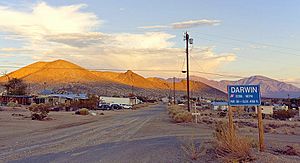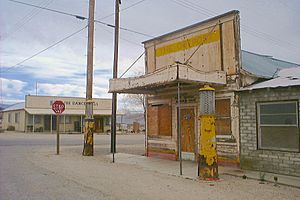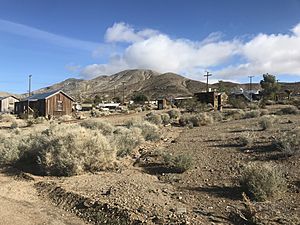Darwin, California facts for kids
Quick facts for kids
Darwin
|
|
|---|---|

Darwin, California
|
|

Location in Inyo County and the state of California
|
|
| Country | |
| State | |
| County | Inyo |
| Area | |
| • Total | 1.34 sq mi (3.48 km2) |
| • Land | 1.34 sq mi (3.48 km2) |
| • Water | 0.00 sq mi (0.00 km2) 0% |
| Elevation | 4,846 ft (1,477 m) |
| Population
(2020)
|
|
| • Total | 36 |
| • Density | 26.77/sq mi (10.33/km2) |
| Time zone | UTC-8 (Pacific (PST)) |
| • Summer (DST) | UTC-7 (PDT) |
| ZIP code |
93522
|
| Area codes | 442/760 |
| FIPS code | 06-18030 |
| GNIS feature ID | 2408642 |
Darwin is a small mining town in Inyo County, California, USA. It's not officially a city, but a special area counted by the government. It is about 22 miles (35 km) southeast of Keeler. In 2010, only 43 people lived there, which was fewer than the 54 people in 2000. By 2020, the population was 36.
Contents
Discovering Darwin: A Town's Past
Darwin got its name from Darwin French, who was a rancher, miner, and explorer. In 1850, French and other prospectors (people looking for valuable minerals) explored this area. He also led a trip into Death Valley in 1860. He was looking for a legendary hidden treasure called the Gunsight Lode.
Mining History and Growth
In 1874, people found silver and lead here, which led to the town being founded. A post office opened in 1875. It closed for a short time in 1902 but is still open today. The town grew when the Eichbaum Toll Road opened in 1926. This road made it easier to get to Death Valley from the west.
Changes and Isolation
When Death Valley became a National Monument in 1933, the government bought the toll road. This made it free for everyone to visit the new park. However, in 1937, a new road was built that went around Darwin. This made the town feel a bit isolated.
Darwin in the News
In 2011, a documentary film called Darwin was made about the town. In 2012, BBC News showed a video where local people talked about wanting faster internet. They hoped to get broadband instead of slow dial-up Internet access.
Where is Darwin?
Darwin is located in Inyo County, California. It covers an area of about 1.3 square miles (3.48 square kilometers). All of this area is land. The government defines this area for counting people and statistics.
Who Lives in Darwin?
Darwin is a very small community. Here's a quick look at its population over time:
- 2000: 54 people
- 2010: 43 people
- 2020: 36 people
People in 2010
In 2010, 43 people lived in Darwin. Most of the people (88%) were white. There were also some Native American and Asian American residents. About 5% of the people were Hispanic or Latino.
Most people lived in homes, not in group housing. There were 28 households in total. Many households (50%) had just one person living there. About 32% of homes had someone 65 or older living alone. The average household had 1.5 people.
The people living in Darwin were generally older. Almost half (49%) were 65 or older. The median age was 63.5 years. This means half the people were older than 63.5, and half were younger.
Most homes (86%) were owned by the people living in them. Only a few (14%) were rented.
See also
 In Spanish: Darwin (California) para niños
In Spanish: Darwin (California) para niños




